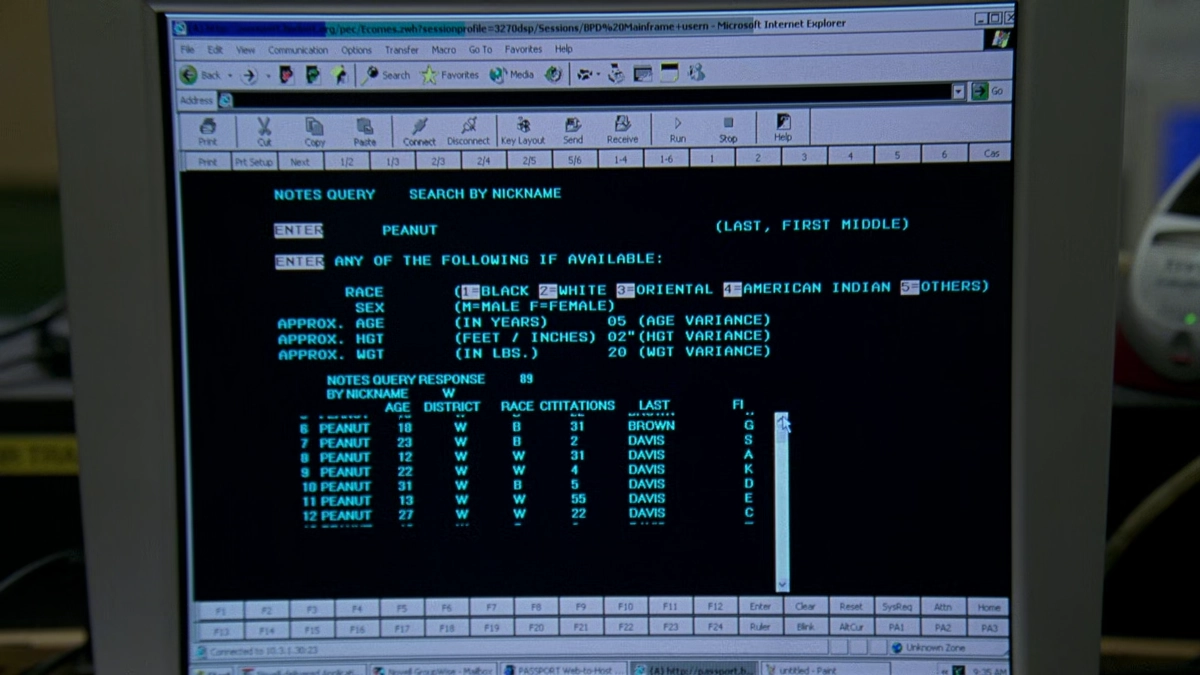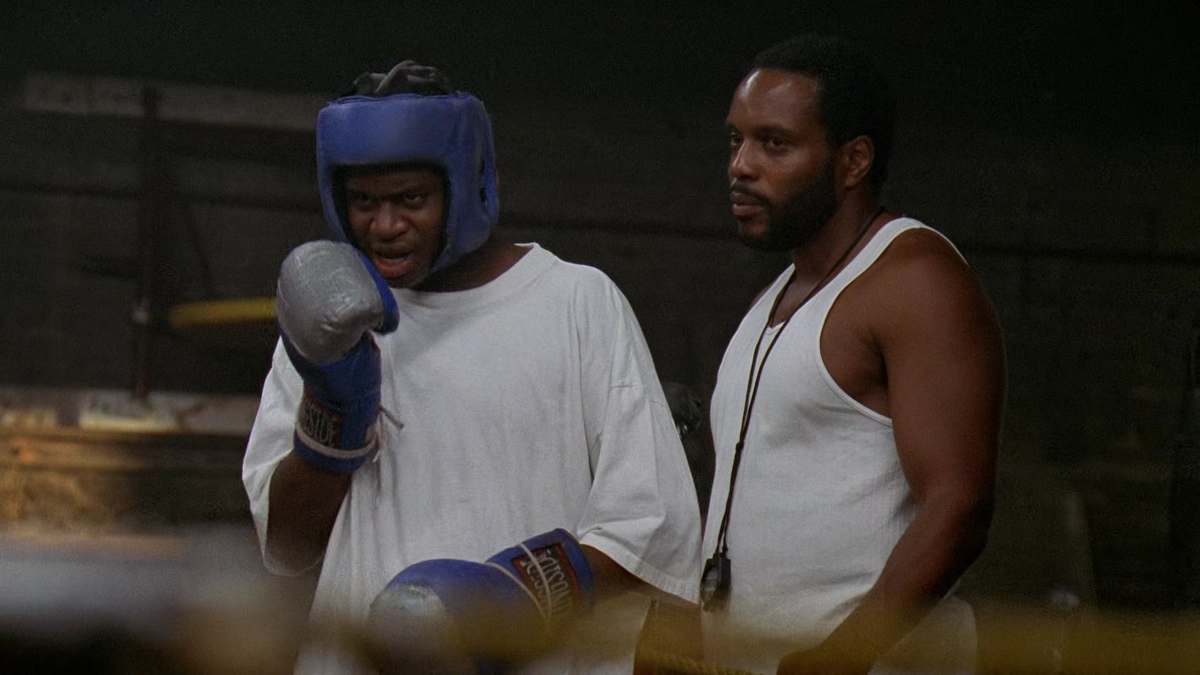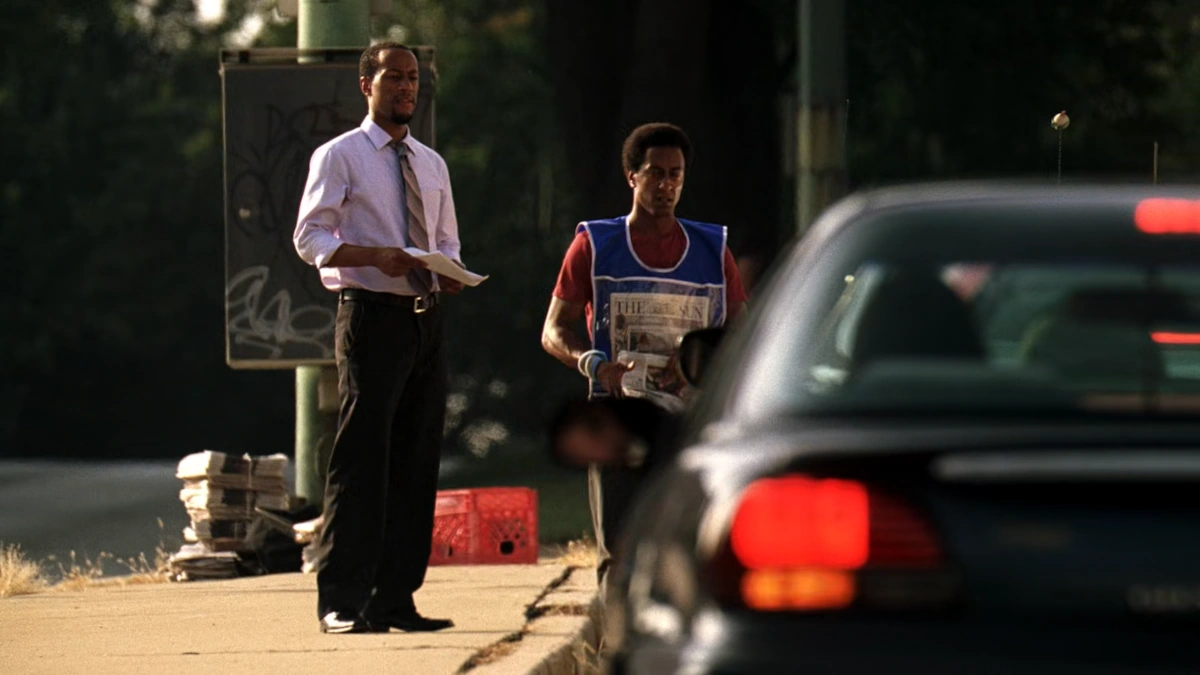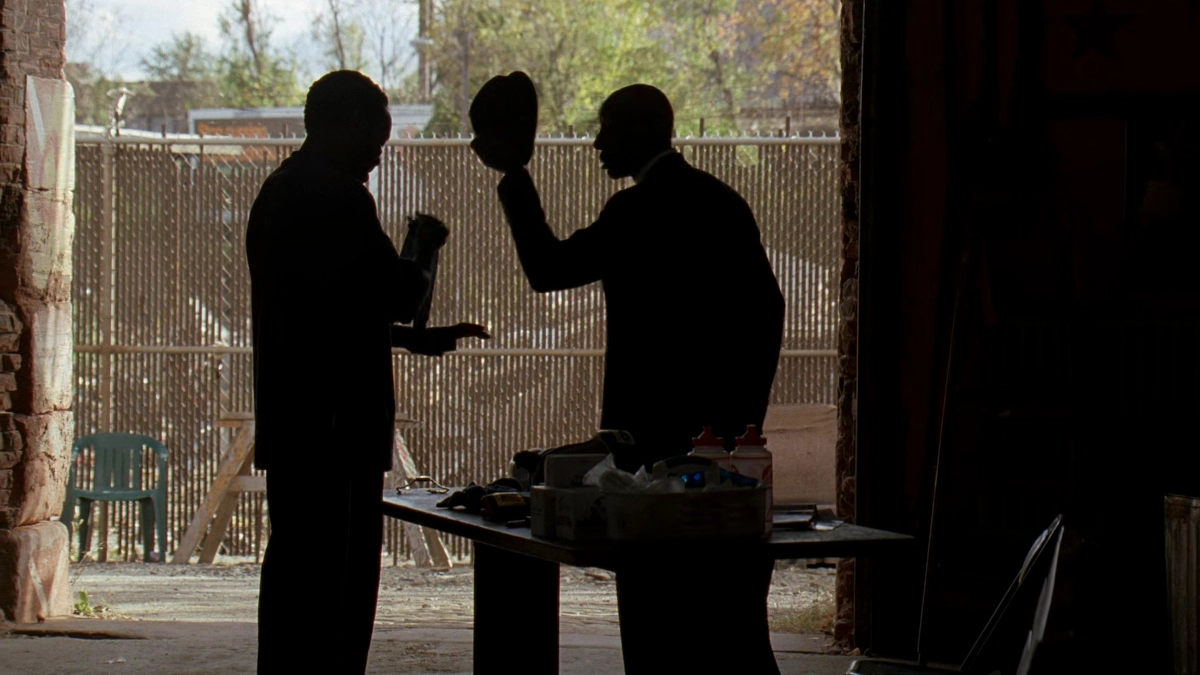On my first watch through of The Wire, many subtle details slipped past me. On my re-watches I started to pay extra attention to the background details. That way, I was able to pick up many lies, rumors, exaggerations, urban legends and references within the show which helped greatly to flesh out The Wire universe.
Contents
- Frank “Pee Wee” Matthews
- Edgar Allan Poe (Edward Allan Poorhouse)
- George Washington Carver
- Stringer schooled Marlo about old smart gangsters in the history.
- Stringer wanted to run the city like Little Willie
- War between Kenny Bird and Peanut King
- Bumpy from New York
- Dennis Wise (Cutty) set to be the new Angelo Dundee
- The disappearance of Eddy Robert Crane
- AJ from North & Woods
- Scott Templeton is not exactly Bob Woodward
- The Jimmy Breslin of Baltimore
- “It ain’t exactly Studs Terkel”
- News story about Bubbles is a character study like a Joe Mitchell article
- The Blairs, the Glasses, the Kellys, they always start with something small
Frank “Pee Wee” Matthews
Two old timers were arguing over the reason to the difference between East-side and West-side people. One man was saying that East-side people are wilder because they drink port wine while West-side people drink Sherry. When they asked for Butchie’s opinion, Butchie told them the beginning of the difference started with Frank Matthews. Frank Matthews had partnered with New York Italians to get the French connection which provided a steady supply of dope to the West Baltimore. When the supply is steady, the game runs like a business and reduce the unwanted violence.
Frank Matthews aka Black Caesar was one of the top ten drug traffickers in U.S. history according to the DEA. He hosted African-American and Hispanic drug dealers’ summits in 1971 and 1972 to figure out a way to break free from American mafia control of the drug trade. In 1973 he disappeared with 20 million dollars’ worth of savings to never to be seen again.
Edgar Allan Poe (Edward Allan Poorhouse)
Two thugs were guarding a Barksdale stash house. One was telling about an incident that happened to him when he was in Carlton. An old man and his wife approached him to ask for the directions to “the Poe House.” Young thug thought they were asking for a poorhouse which were plentiful in the area, so the thug said to the old man to pick any house from the area. Then the Oldman clarified by asking for the Edgar Allan Poe’s house to which the young man replied “I don’t know no Edward Allan Poe.” Oldman gave a disbelieving look like somehow the young man had let him down. No wonder they had no idea about Edgar Allan Poe, because one of them was Chipper who was dumb enough to ignore all the planning of Slim Charles and Cutty to drive prematurely into one of Marlo’s corners and got himself and Country killed.
Baltimorean thugs may have not heard about him, but Edgar Allan Poe’s name rings out in the world of literature. Edgar Allan Poe was an important author who had made great contributions to the English literature. He is well known for his work in macabre genre which is fitting with the themes of the Wire. Edgar Allan Poe lived and died in Baltimore. He is buried at Westminster Hall in Baltimore.
George Washington Carver

Officer Dozerman got shot and someone stole his service weapon. Top people in the police department demanded detectives to find that gun and Bunk Moreland ended up with the task. Bunk got a tip that someone named Peanut shot officer Dozerman. When Bunk entered ‘Peanut’ into the computer, it gave back 89 people with nickname Peanut just in West Side of Baltimore. Detective Vernon Holley saw the long list and told Bunk “Find some way to work with all them peanuts.”
Bunk snapped back “Motherfucker, do I look like George Washington Carver?”
On another scene Bunk was arguing with Detective Michael Crutchfield about Omar Little’s involvement in the murder of the delivery lady. Crutchfield did not care whether Omar was guilty for the particular crime or not because Omar was a suspect for many other crimes. Crutchfield told to Bunk “And look who you talking about. This ain’t the motherfucker that came up with 62 ways for the peanut.”
In both instances they were referring to George Washington Carver who was a prominent Black scientist. He was born into slavery and later in life became an agricultural scientist and a professor. He encouraged poor farmers to plant alternate crops to avoid soil depletion. He was known for developing many products using peanuts. His bulletins for farmers had contained 105 recipes for peanuts.
Stringer schooled Marlo about old smart gangsters in the history.

Stringer met Marlo to end their beef and invited him to the co-op. Stringer admired Malo’s intelligence and told him there were many intelligent players in the game before them like Melvin, Little Will, Big Head Brother, Peanut, Warren. But soon as their names rang out, Feds had took them down.
Melvin – I think Stringer was referring to the actor who played Deacon in the Wire. His name was Melvin Williams aka Little Melvin, Slim, and Black. He was a notorious drug kingpin back in the day.
Little Will – Either Stringer was referring to Melvin (again) or Little Willie. William L. Adams aka Little Willie was a millionaire in Baltimore. He ran an illegal lottery. But he was not in the drug game and Feds did not take him down. More on him later.
Big Head Brother – He was a major drug dealer in his area who also sold wholesale packages to other dealers.
Peanut – It looks like Peanut is a popular nickname in the Wire universe, so it is hard to tell which Peanut that Stringer was referring to. In real life there is Maurice “Peanut” King aka Peanut King who was a drug kingpin in East Baltimore. More about him later.
Warren – Stringer must be talking about Warren “Black” Boardley. He was the leader of a gang who controlled the drug trade in Lexington Terrace high-rises in West Baltimore which were the inspiration for Franklin Terrace towers of the Barksdale crew. Edward P. Burns, the co-creator of the Wire himself helped to bring down Warren Boardley. When Ed Burns was still a homicide detective he made a deal with Donnie Andrews who was the real life inspiration for Omar Little, and also had a minor role in The Wire. Donnie was an enforcer for Warren and got locked up for a murder charge. Ed Burns convinced Donnie Andrews to wear a wire in exchange for a reduced sentence. Evidence from the wire helped to put Warren Boardley 47 years behind bars. Warren got out after 27 years and joined a boxing gym to train young kids like what Cutty did in the show.
Stringer wanted to run the city like Little Willie
After Avon got out he was furious because his crew did not have better corners. Stringer tried to talk sense into Avon by pointing out that they are rich enough to finance a package and let next generation of gangsters to figure out retail logistics. He wanted to turn their wealth into legitimate businesses and become a bank.
Stringer said to Avon “We could do like Little Willie back in the day with all that number money, and run this goddamn city.”
As I mentioned earlier, William Lloyd “Little Willie” Adams ran an illegal lottery operation in his youth and turned that money into legitimate businesses. In his day it was hard for African American businessmen to get loans from banks. Little Willie took that opportunity to bankroll many businesses in return for a business share. After he became wealthy and well connected, his influence over politics in the city also grew.
In an interview William Adams said that he had one goal, which was to make some money and go into legitimate businesses. He was able to realize his goal. Stringer also had that dream. It was unfortunate that Avon was not able to shake down his corner mentality.
War between Kenny Bird and Peanut King
After Gerard and Sapper shot at Omar and ruined his grandma’s church crown, he met with Butchie. Butchie said even Kenny Bird and Peanut had respected the Sunday Truce during their war.
Kenneth Jackson aka Kenny Bird was a lieutenant under Melvin Williams aka Little Melvin (Actor who played Deacon). Maurice “Peanut” King was the leader of one of the largest criminal organizations in the Baltimore at his time. Kenny Bird and Peanut King were beefing over some real-estate in 80s.
Bumpy from New York
Do you remember the time where one of Cheese’s people shot a boy over a dog fight? Well, the dead boy, Jelly was telling a story to Sherrod and another boy just before he got shot. According to Jelly, the baddest gangster of all time was Bumpy from New York. And then he proceeded to tell antics of Bumpy.
Jelly was most probably talking about Ellsworth Raymond Johnson aka Bumpy Johnson. Obviously Jelly was exaggerating stories about Bumpy Johnson. Nonetheless, Bumpy Johnson was an interesting enough character so that fictionalized versions of him had appeared in movies and TV shows such as American Gangster (2007) and Godfather of Harlem.
Dennis Wise (Cutty) set to be the new Angelo Dundee

After releasing from the prison, Cutty had to find a job as per his parole agreements. He found a job as a day laborer under a landscaping contractor. That contractor (Played by Eugene R. Little) played a vital part in Cutty’s redemption arc. He knew exactly what was Cutty going through and laid out the reality of an ex-con who is looking for honest day’s work. He also saw the potential in Cutty. Cutty was hard working, learning fast about his trade and learning to speak Spanish better than his boss. So Cutty’s boss, the landscaping crew chief invited Cutty to join him and lead a second crew so they could cover twice the workload.
Cutty refused the offer saying “Nah man, I got other obligations.”
Crew chief replied “Oh right, you set to be the new Angelo Dundee.”
Angelo Dundee was a boxing trainer and a cornerman. He had worked with one of the greatest boxers of all time, Muhammad Ali and many other boxing world champions. He worked as Ali’s cornerman for almost all of his fights.
Cutty himself was a boxer. He decided to drop his street name and fully embrace his civilian self, Dennis Wise. With the help of the Deacon and many others, Dennis opened a boxing gym to train kids. There was a scene where he was actually showing a boxing fight between Muhammad Ali vs. Floyd Patterson to his students.
The disappearance of Eddy Robert Crane
In a bar scene, Detective Bunk was looking to score some pussai. His partner, Detective Lester wasn’t even paying attention to Bunk. Lester was thinking loudly what is happening to Marlo’s victims. He theorized many ways that Marlo could use for disappearing bodies including a rouge funeral home. Then he said to Bunk “You remember the Eddy Crane case? Word was they put him in an acid vat down near Curtis Bay.”
Eddy Robert Crane was a local businessman in South Baltimore. In 1987 he went missing and police investigators were able to gather circumstantial evidence to support the theory that Eddy Crane was murdered in his workplace office. They uncovered bullet holes, blood spatters and attempted cleanup efforts. But they never found his body. David Simon wrote an article about Eddy Crane’s disappearance to The Baltimore Sun.
AJ from North & Woods
In the very first scene of the Namond, Randy, Michael and Dukie together, Namond was reading a Don Diva magazine. Randy asked Namond what he was reading. Namond replied he was reading a story about AJ from North & Woods who got 700 years.
I could not find anything about an AJ who got 700 years sentence. So maybe it’s not a reference, could be just a fictional story.
Scott Templeton is not exactly Bob Woodward
Scott was assign to interview homeless people regarding recent homeless killings. He went to the soup kitchen and interviewed many poor people without verifying whether they were homeless or not. The old man who manage the soup kitchen realized Scott’s mistake, but did not choose to correct him because he thought Scott was having a good time. Later the old man told to Bubbles “The reporter the Sun paper sent over, not exactly Bob Woodward.” Indicating that Scott Templeton lacks the investigative skills.
Robert Upshur Woodward is an investigative journalist who had covered important stories for The Washington Post. He got famous for covering the Watergate Scandal which eventually led up to the resignation of President Richard Nixon.
After reading more about Bob Woodward, I found some interesting connections between him and Scott Templeton. Some critics of Woodward think he had fabricated some of his stories. Woodward also favors unnamed informants as his sources for news reports and his books. When he was the assistant managing editor for The Washington Post he defended a post called Jimmy’s World by Janet Cooke while many people doubted it as a fabricated story because it was about an eight years old heroin addict, and nobody could find the boy. But Woodward stood by Cooke and believed her story and he submitted it for the Pulitzer Prize for Feature Writing which it won. It all familiar with how Scott Templeton fabricated his serial killer story, James Whiting and Thomas Klebanow stood by him and finally the story won the Pulitzer Prize. But unlike in Templeton’s case, Janet Cooke’s stories crumbled under scrutiny and revealed that she had fabricated Jimmy’s World report, so first time in the history a winner had to return their Pulitzer Prize.
The Jimmy Breslin of Baltimore
Scott Templeton’s serial killer reporting got national attention and he got invitations form national television shows. In such interview Nancy Grace compared Scott Templeton’s story to the Son of Sam contacting Jimmy Breslin.
Jimmy Breslin was a famous investigative reporter and a winner of the Pulitzer Prize for Commentary. He was known for his interviews of the common people. In his career he covered about an American serial killer known as the Son of Sam. Son of Sam wrote a letter to Breslin during his crime spree. Breslin published that letter withholding some details in the ‘Daily News’ newspaper making it is the highest selling Daily News edition at the time.
“It ain’t exactly Studs Terkel”
Scott Templeton was sent to interview homeless people and he wasted his time interviewing low income people in a soup kitchen without realizing they were not homeless people. Then he had the bright idea to spend a night with homeless people, so he spent a one night under a bridge with homeless people. But at the end he wrote a colorful article which reads like Scott had risked his life days interviewing homeless people. Gus, the city desk editor opposed to publish Scott Templeton’s fluff story pointing out Scott only spent one night out, so “It ain’t exactly a Studs Terkel.” But Whiting and Klebanow green lit the story to be publish.
Louis “Studs” Terkel was an actor, a broadcaster and a Pulitzer Prize winning writer. He composed recollections of experiences of ordinary people to preserve the oral history of World War 2 and wrote a book called ‘The Good War: An Oral History of World War Two’ which won the Pulitzer Prize for General Non-Fiction.
News story about Bubbles is a character study like a Joe Mitchell article

Baltimore Sun news reporter Mike Fletcher met Reginald “Bubbles” Cousins when he visited the soup kitchen. Mike took interest in Bubbles life and decided to write an article about him. So he followed Bubble, observed him, interviewed him and ultimately attended his N.A. (Narcotics Anonymous) meeting where Bubbles finally revealed his honest mind and talked about Sherrod’s death. Mike wrote the article and showed it to Gus. Gus complemented it by saying he really felt like he knows bubbles and his world, and said “You got some real Joe Mitchell stuff on the page there.” When Bubbles showed the draft to Waylon, he also said that the reporter has really captured the essence of Bubbles.
Joseph Mitchell was a reporter who was well known for his character study writing style. He studied unassuming characters in the New York City and wrote about them to The New Yorker magazine.
The Blairs, the Glasses, the Kellys, they always start with something small
Scott Templeton claimed that he saw a guy tried to pull a vagrant into a grey van. Police soon realized it was a lie and said so to The Baltimore Sun. Thomas Klebanow argued that police may be not doing their job properly and decided to print the news, but Augustus “Gus” Haynes implied that Scott was manufacturing news. Klebanow pointed out that the Serial Killer really contacted Scott Templeton, therefore Scott couldn’t be lying. Gus replied “The Blairs, the Glasses, the Kellys, they always start with something small”, and also said it always starts with something true.
Jayson Thomas Blair is a former The New York Times reporter. He got accused of plagiarizing an article from San Antonio Express-News. The New York Times editors inquired the allegation and it led to the revelation of Jayson Blair’s long history of plagiarisms, fabrications and lies in his news reports.
Stephen Randall Glass is a former journalist who worked for The New Republic magazine. During his time as a journalist, he had fabricated many stories. Internal investigation of The New Republic revealed that 27 articles from total of 41 articles which were wrote by Glass had contained fabrications.
Jack Kelley was a foreign correspondent for the USA Today newspaper and a nominee for the Pulitzer Prize. Later it was revealed that he had been fabricating news stories and enlisting random people to act as his news sources in case the newspaper decides to fact check. When everything blew up and the newspaper launched an investigation to fact check his stories, he wrote scripts and gave them to people including some of his colleges so they could lie for him.
When Gus was telling Klebanow that fabricators always start small and soon evolve into seeing amazing things and find themselves in the right place at the right time like witnessing a bomb explosion in a pizzeria and heads rolling down the streets, Gus was actually referencing one of Jack Kelley’s news reports.


Leave a Reply